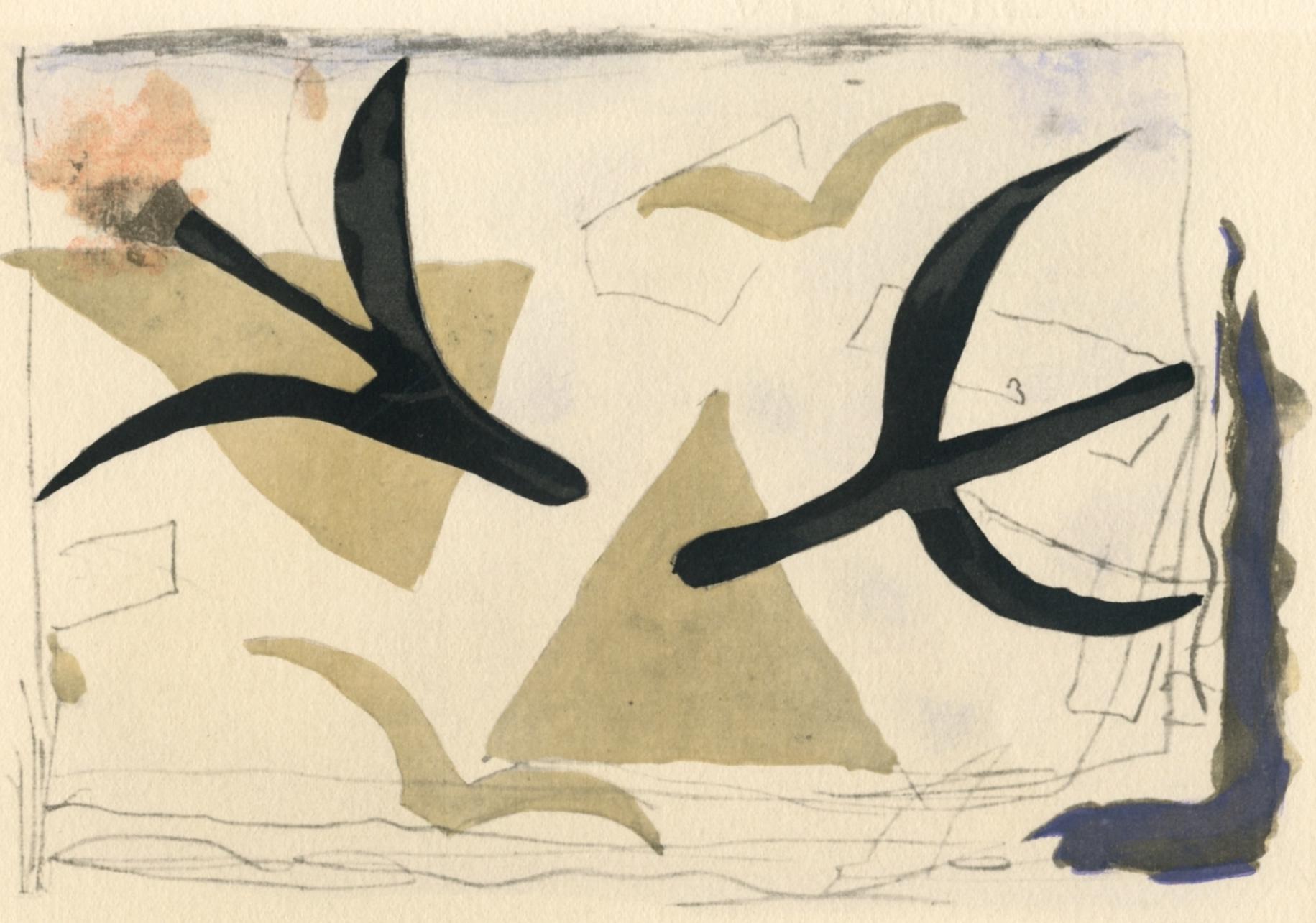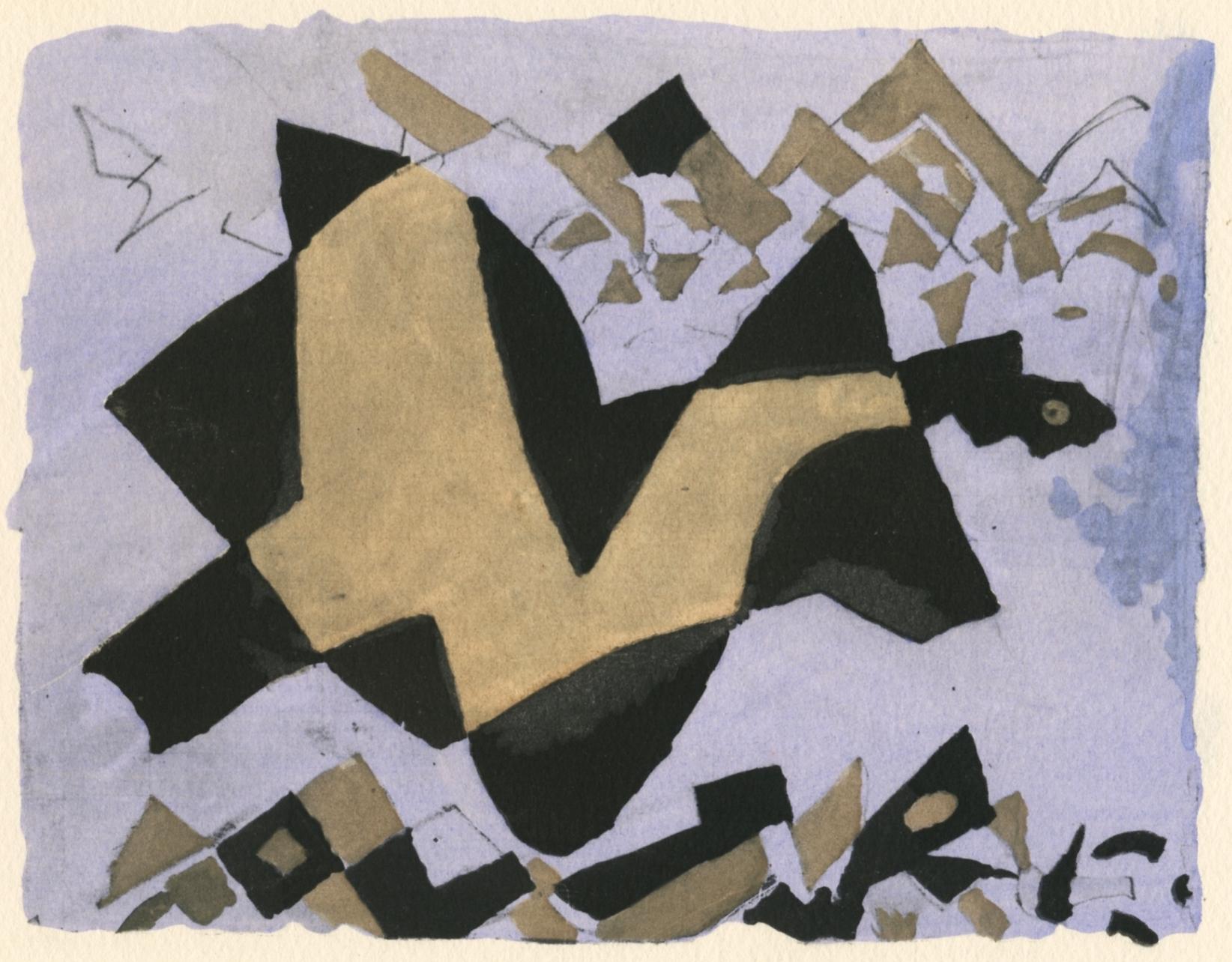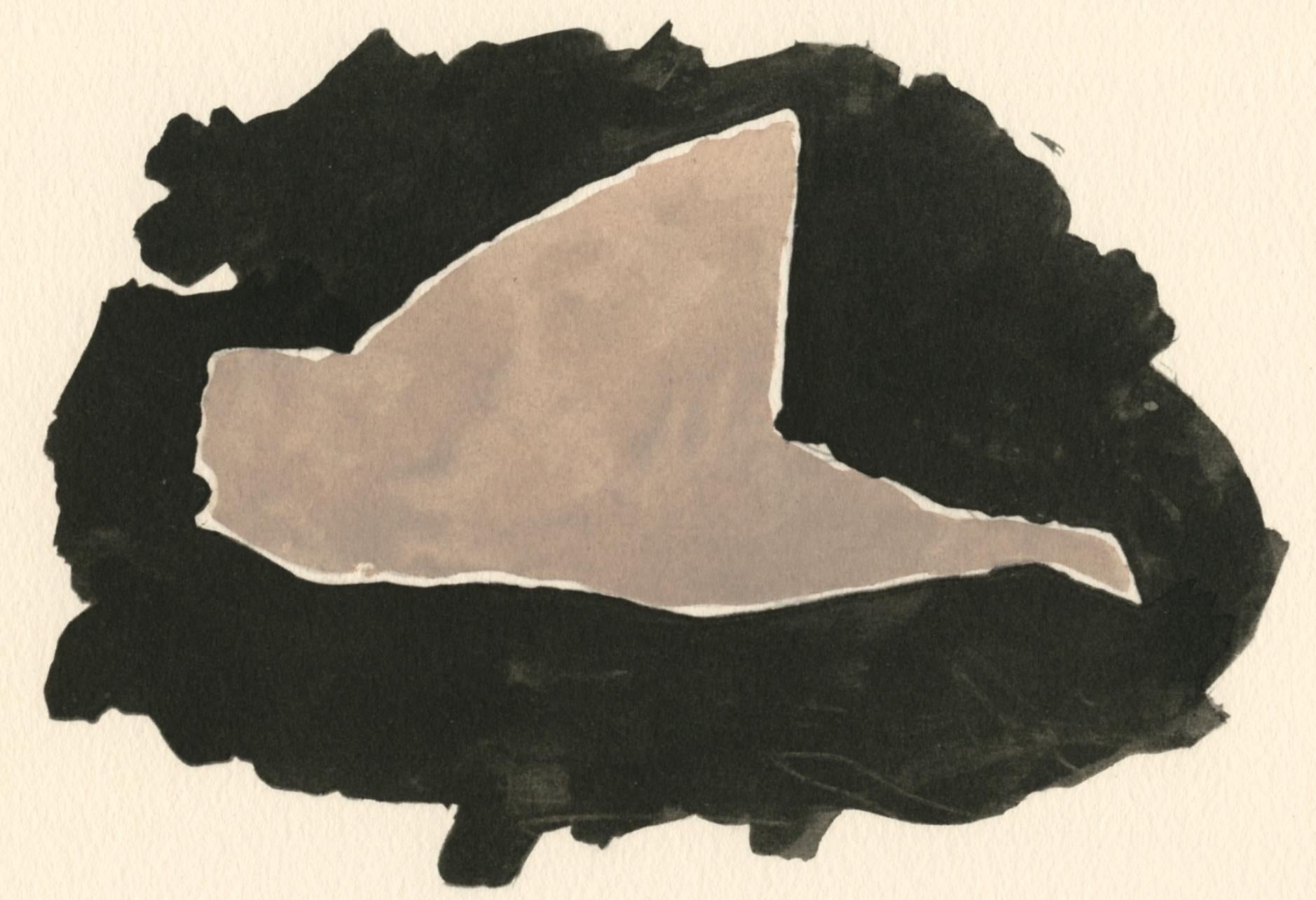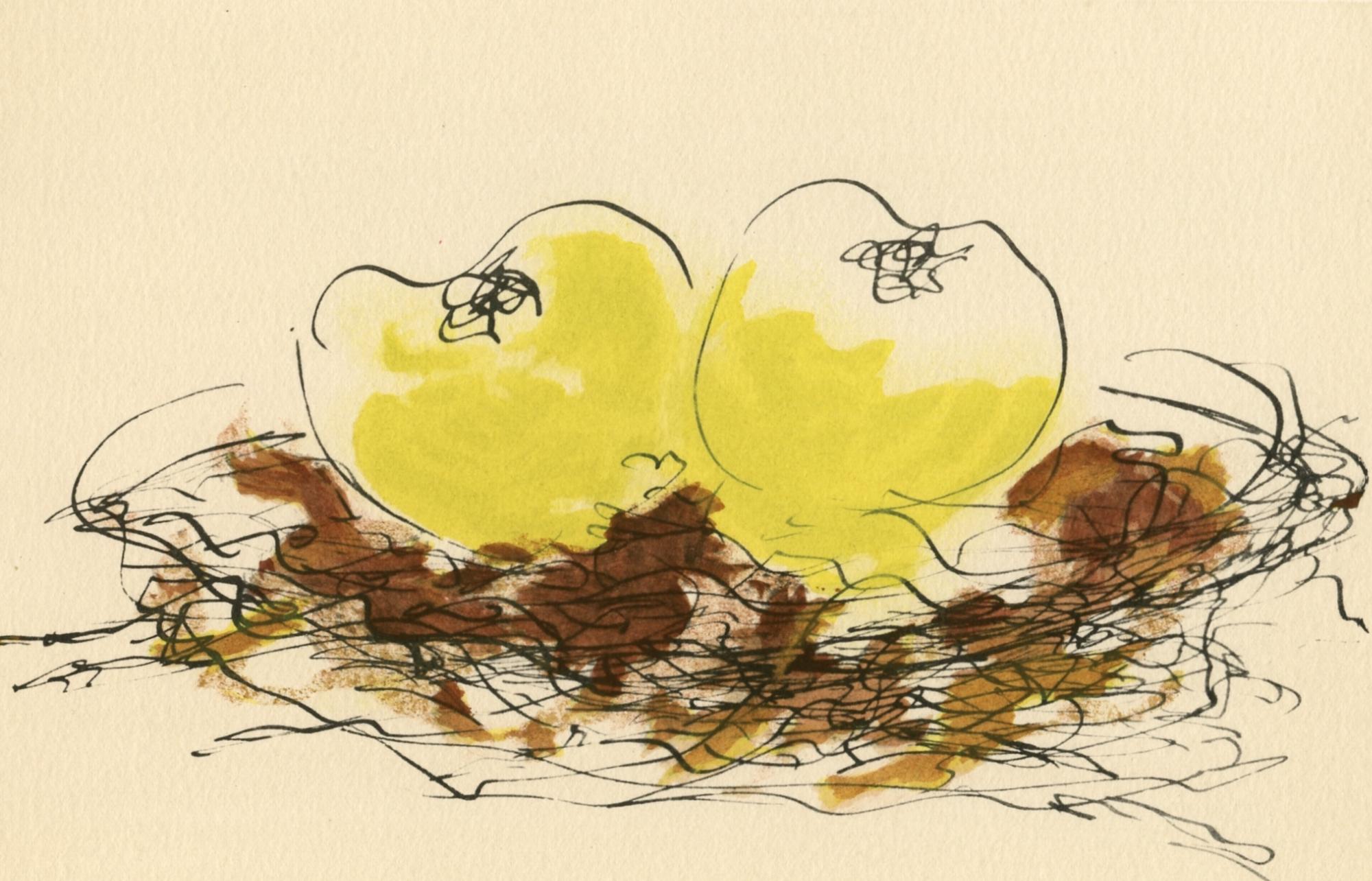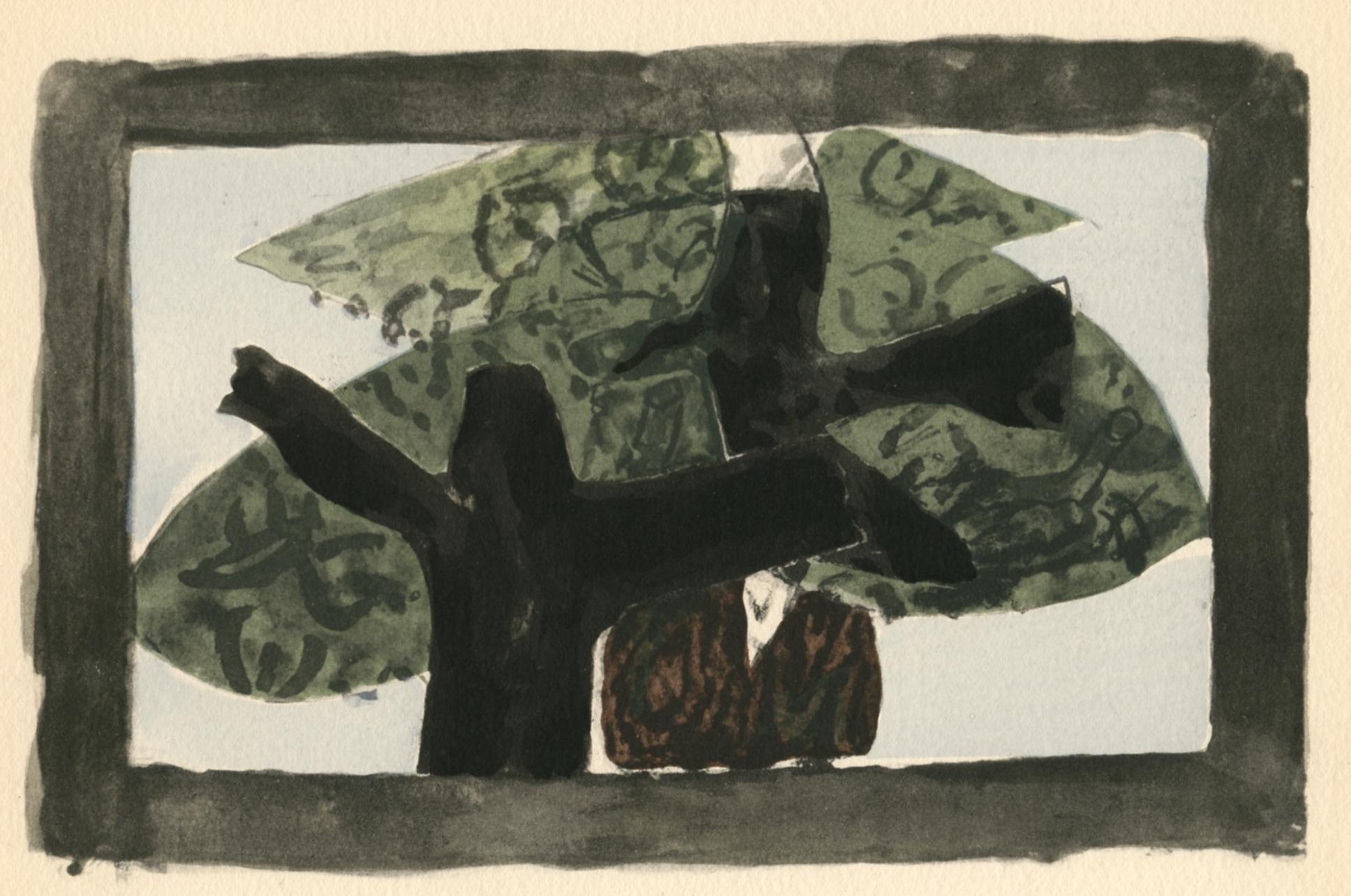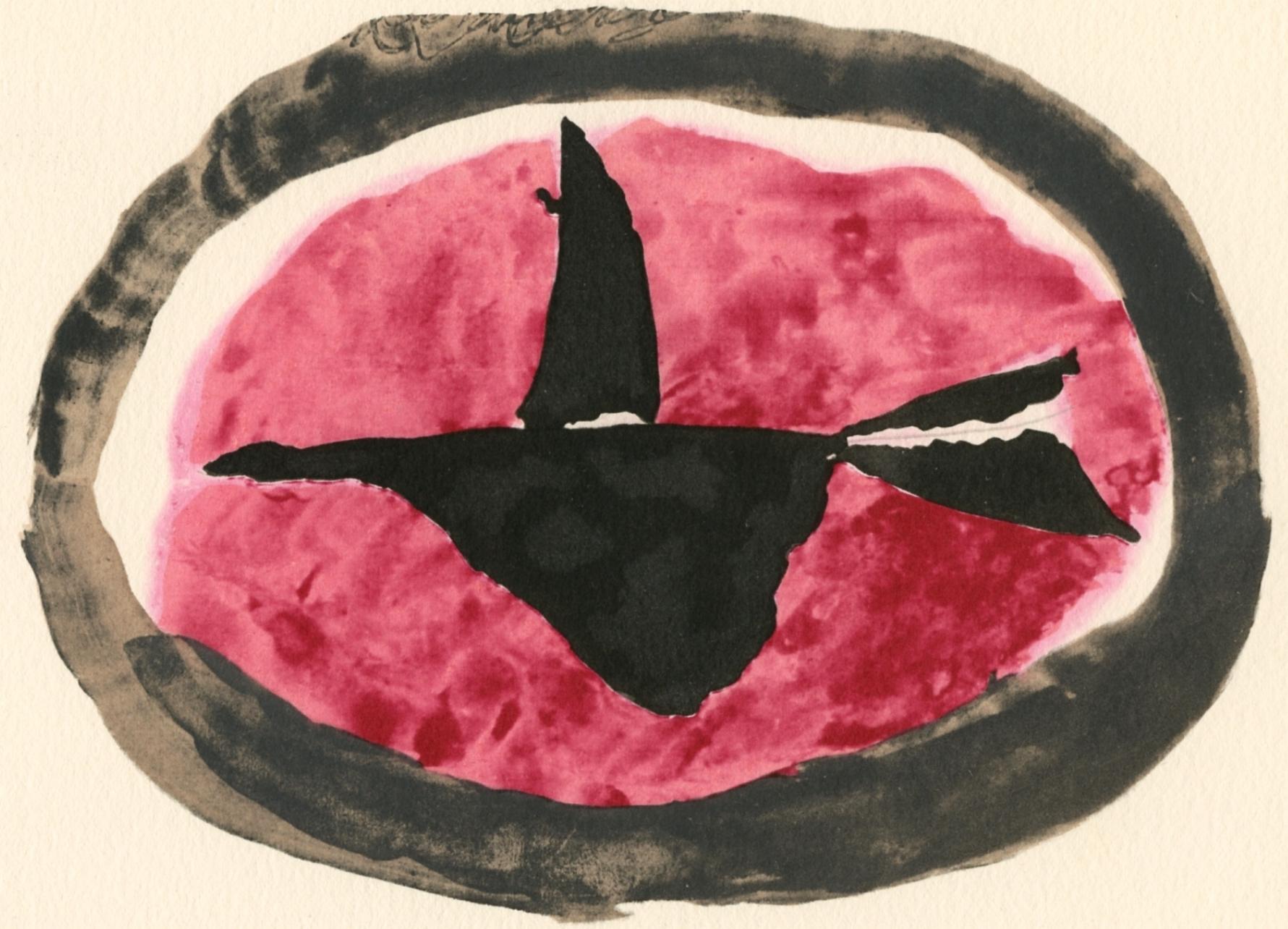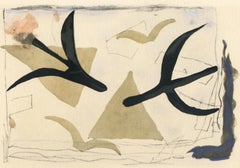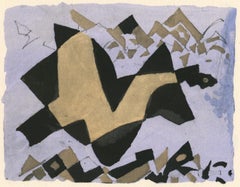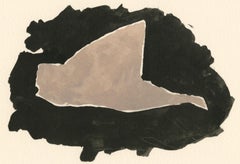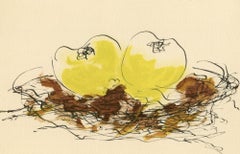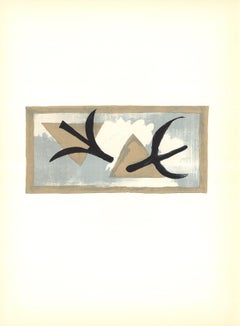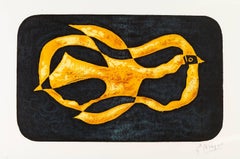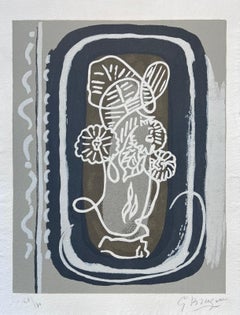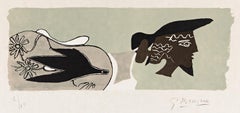Items Similar to Georges Braque, Form, from Le Solitaire, XXe siecle, 1959 (after)
Want more images or videos?
Request additional images or videos from the seller
1 of 8
Georges Braque, Form, from Le Solitaire, XXe siecle, 1959 (after)1959
1959
$716
$89520% Off
£546.29
£682.8620% Off
€621.91
€777.3920% Off
CA$1,006.35
CA$1,257.9320% Off
A$1,106.22
A$1,382.7720% Off
CHF 580.76
CHF 725.9520% Off
MX$13,153.74
MX$16,442.1820% Off
NOK 7,458.28
NOK 9,322.8520% Off
SEK 6,793.68
SEK 8,492.1120% Off
DKK 4,646.65
DKK 5,808.3220% Off
About the Item
This exquisite lithograph and pochoir after Georges Braque (1882–1963), titled Forme (Form), from the album Georges Braque, Le Solitaire (The Solitary), originates from the 1959 edition published by XXe siecle, Paris, in collaboration with Fernand Hazan, Paris; rendered by Daniel Jacomet, Paris; and printed by Daniel Jacomet et Cie, Paris, 1959. Forme (Form) encapsulates Braque’s mature synthesis of structure and intuition, exploring the poetic equilibrium between abstraction and nature. In this composition, Braque transforms geometric simplicity into meditative lyricism, emphasizing the silent dialogue between color, form, and spatial rhythm. The refined surface and deliberate restraint evoke a timeless stillness—an aesthetic of contemplation central to Braque’s late period, when art became a reflection of inner harmony and philosophical depth.
Executed as a lithograph and pochoir on velin d’Arches paper, this work measures 7.25 x 9.375 inches. Unsigned and unnumbered as issued. The edition exemplifies the technical excellence of Daniel Jacomet et Cie, Paris, produced in close collaboration with XXe siecle and Fernand Hazan, Paris.
Artwork Details:
Artist: After Georges Braque (1882–1963)
Title: Forme (Form), from the album Georges Braque, Le Solitaire (The Solitary), 1959
Medium: Lithograph and pochoir on velin d’Arches paper
Dimensions: 7.25 x 9.375 inches (18.42 x 23.81 cm)
Inscription: Unsigned and unnumbered as issued
Date: 1959
Publisher: XXe siecle, Paris, in collaboration with Fernand Hazan, Paris
Printer: Daniel Jacomet et Cie, Paris
Condition: Well preserved, consistent with age and medium
Provenance: From the album Georges Braque, Le Solitaire, published by XXe siecle, Paris, in collaboration with Fernand Hazan, Paris; rendered by Daniel Jacomet, Paris; and printed by Daniel Jacomet et Cie, Paris, 1959
Notes:
Excerpted from the album (translated from French): XXX examples of this work were printed on Arches paper, containing an original engraving by Georges Braque, numbered from I to XXX. CM examples, constituting the original edition, including CCC for F. Hazan, publisher in Paris, CCC for A. Zwemmer, publisher in London, and CCC for the New York Graphic Society, LX examples, marked H.C., are reserved for the Author and the Publisher.
About the Publication:
Georges Braque, Le Solitaire (The Solitary) was published in Paris in 1959 by XXe siecle in collaboration with Fernand Hazan and printed by the Atelier Daniel Jacomet et Cie. Conceived as both a visual and literary homage to one of the founding figures of Cubism, the volume represents one of the most refined art book productions of the postwar era. The publication was issued in conjunction with the journal XXe siecle, under the direction of G. di San Lazzaro, a central figure in promoting modern art through his collaborations with artists such as Picasso, Miro, Chagall, and Calder. Le Solitaire brought together Braque’s mature reflections on nature, still life, and metaphysical quietude, accompanied by critical essays and reproductions of his work. The pochoir and lithographic plates—executed by Daniel Jacomet, whose atelier was renowned for its exceptional color pochoirs—capture the texture and tonal depth of Braque’s original paintings with rare precision.
About the Artist:
Georges Braque (1882–1963) was a French painter, sculptor, and printmaker whose pioneering vision transformed the course of 20th-century art. A central figure in modernism and the co-founder of Cubism alongside Pablo Picasso, Braque redefined visual perception by breaking objects into geometric forms and reassembling them from multiple perspectives, creating a new visual language that bridged the gap between abstraction and reality. His early work was influenced by the vibrant colors and expressive energy of the Fauvist painters Henri Matisse and Andre Derain, before evolving toward the more analytical and structured compositions inspired by Paul Cezanne’s theories of form and perspective. Braque’s collaboration with Picasso between 1908 and 1914 marked one of the most fertile and revolutionary periods in art history, resulting in works that challenged traditional notions of space, depth, and illusion. Throughout his career, Braque maintained a deep interest in harmony, rhythm, and balance, infusing his still lifes, landscapes, and later reliefs with poetic subtlety and intellectual rigor. He moved among a brilliant circle of contemporaries including Pablo Picasso, Henri Matisse, Marc Chagall, Juan Gris, Fernand Leger, and Amedeo Modigliani—artists united in their pursuit of new modes of artistic expression. Braque’s influence extended well beyond his own era, shaping the creative approaches of later modernists such as Alexander Calder, Alberto Giacometti, Salvador Dali, Joan Miro, Wassily Kandinsky, Marcel Duchamp, and Man Ray, all of whom drew inspiration from his structural innovations and aesthetic integrity. His works are held in major museum collections worldwide, including the Museum of Modern Art, the Centre Pompidou, the Tate, and the Guggenheim, where they continue to embody the essence of modern artistic thought and visual poetry. The highest price ever paid for a Georges Braque artwork is approximately 15 million USD, achieved in 2013 at Christie’s New York for Paysage a la Ciotat (1907).
Georges Braque Forme, Braque Le Solitaire, Braque XXe siecle, Braque Fernand Hazan, Braque Daniel Jacomet.
- Creation Year:1959
- Dimensions:Height: 7.25 in (18.42 cm)Width: 9.375 in (23.82 cm)
- Medium:
- Movement & Style:
- After:Georges Braque (1882 - 1963, French)
- Period:
- Condition:
- Gallery Location:Southampton, NY
- Reference Number:1stDibs: LU1465216690192
About the Seller
4.9
Platinum Seller
Premium sellers with a 4.7+ rating and 24-hour response times
Established in 1978
1stDibs seller since 2021
1,243 sales on 1stDibs
Typical response time: <1 hour
- ShippingRetrieving quote...Shipping from: Southampton, NY
- Return Policy
More From This Seller
View AllGeorges Braque, Study of Birds, from Le Solitaire, XXe siecle, 1959 (after)
By Georges Braque
Located in Southampton, NY
This exquisite lithograph and pochoir after Georges Braque (1882–1963), titled Etude oiseaux (Study of Birds), from the album Georges Braque, Le Solitaire (The Solitary), originates ...
Category
1950s Cubist Abstract Prints
Materials
Lithograph
$716 Sale Price
20% Off
Free Shipping
Georges Braque, Study for a Bird, from Le Solitaire, XXe siecle, 1959 (after)
By Georges Braque
Located in Southampton, NY
This exquisite lithograph and pochoir after Georges Braque (1882–1963), titled Etude pour un oiseau (Study for a Bird), from the album Georges Braque, Le Solitaire (The Solitary), or...
Category
1950s Cubist Abstract Prints
Materials
Lithograph
$716 Sale Price
20% Off
Free Shipping
Georges Braque, Le canard, from Le Solitaire, XXe siecle, 1959 (after)
By Georges Braque
Located in Southampton, NY
This exquisite lithograph and pochoir after Georges Braque (1882–1963), titled Le canard (The Duck), from the album Georges Braque, Le Solitaire (The Solitary), originates from the 1...
Category
1950s Cubist Abstract Prints
Materials
Lithograph
$716 Sale Price
20% Off
Free Shipping
Georges Braque, Apples, from Le Solitaire, XXe siecle, 1959 (after)
By Georges Braque
Located in Southampton, NY
This exquisite lithograph and pochoir after Georges Braque (1882–1963), titled Pommes (Apples), from the album Georges Braque, Le Solitaire (The Solitary), originates from the 1959 e...
Category
1950s Cubist Abstract Prints
Materials
Lithograph
$716 Sale Price
20% Off
Free Shipping
Georges Braque, The Tree, from Le Solitaire, XXe siecle, 1959 (after)
By Georges Braque
Located in Southampton, NY
This exquisite lithograph and pochoir after Georges Braque (1882–1963), titled L’arbre (The Tree), from the album Georges Braque, Le Solitaire (The Solitary), originates from the 195...
Category
1950s Cubist Abstract Prints
Materials
Lithograph
$716 Sale Price
20% Off
Free Shipping
Georges Braque, Bird at Sunset, from Le Solitaire, XXe siecle, 1959 (after)
By Georges Braque
Located in Southampton, NY
This exquisite lithograph and pochoir after Georges Braque (1882–1963), titled Oiseau au couchant (Bird at Sunset), from the album Georges Braque, Le Solitaire (The Solitary), originates from the 1959 edition published by XXe siecle, Paris, in collaboration with Fernand Hazan, Paris; rendered by Daniel Jacomet, Paris; and printed by Daniel Jacomet et Cie, Paris, 1959. Oiseau au couchant (Bird at Sunset) reflects Braque’s meditative engagement with the motif of the bird—an enduring symbol of transcendence, freedom, and poetic solitude in his mature work. Through simplified form and muted harmony, the composition evokes the quiet passage of twilight, translating nature’s fleeting beauty into a timeless visual poem. Braque’s masterful integration of geometric abstraction with lyrical rhythm captures the balance between motion and stillness, light and silence.
Executed as a lithograph and pochoir on velin d’Arches paper, this work measures 7.25 x 9.375 inches. Unsigned and unnumbered as issued. The edition exemplifies the technical excellence of Daniel Jacomet et Cie, Paris, produced in close collaboration with XXe siecle and Fernand Hazan, Paris.
Artwork Details:
Artist: After Georges Braque (1882–1963)
Title: Oiseau au couchant (Bird at Sunset), from the album Georges Braque, Le Solitaire (The Solitary), 1959
Medium: Lithograph and pochoir on velin d’Arches paper
Dimensions: 7.25 x 9.375 inches (18.42 x 23.81 cm)
Inscription: Unsigned and unnumbered as issued
Date: 1959
Publisher: XXe siecle, Paris, in collaboration with Fernand Hazan, Paris
Printer: Daniel Jacomet et Cie, Paris
Condition: Well preserved, consistent with age and medium
Provenance: From the album Georges Braque, Le Solitaire, published by XXe siecle, Paris, in collaboration with Fernand Hazan, Paris; rendered by Daniel Jacomet, Paris; and printed by Daniel Jacomet et Cie, Paris, 1959
Notes:
Excerpted from the album (translated from French): XXX examples of this work were printed on Arches paper, containing an original engraving by Georges Braque, numbered from I to XXX. CM examples, constituting the original edition, including CCC for F. Hazan, publisher in Paris, CCC for A. Zwemmer, publisher in London, and CCC for the New York Graphic Society, LX examples, marked H.C., are reserved for the Author and the Publisher.
About the Publication:
Georges Braque, Le Solitaire (The Solitary) was published in Paris in 1959 by XXe siecle in collaboration with Fernand Hazan and printed by the Atelier Daniel Jacomet et Cie. Conceived as both a visual and literary homage to one of the founding figures of Cubism, the volume represents one of the most refined art book productions of the postwar era. The publication was issued in conjunction with the journal XXe siecle, under the direction of G. di San Lazzaro, a central figure in promoting modern art through his collaborations with artists such as Picasso, Miro, Chagall, and Calder. Le Solitaire brought together Braque’s mature reflections on nature, still life, and metaphysical quietude, accompanied by critical essays and reproductions of his work. The pochoir and lithographic plates—executed by Daniel Jacomet, whose atelier was renowned for its exceptional color pochoirs—capture the texture and tonal depth of Braque’s original paintings with rare precision.
About the Artist:
Georges Braque (1882–1963) was a French painter, sculptor, and printmaker whose pioneering vision transformed the course of 20th-century art. A central figure in modernism and the co-founder of Cubism alongside Pablo Picasso, Braque redefined visual perception by breaking objects into geometric forms and reassembling them from multiple perspectives, creating a new visual language that bridged the gap between abstraction and reality. His early work was influenced by the vibrant colors and expressive energy of the Fauvist painters Henri Matisse and Andre Derain, before evolving toward the more analytical and structured compositions inspired by Paul Cezanne’s theories of form and perspective. Braque’s collaboration with Picasso between 1908 and 1914 marked one of the most fertile and revolutionary periods in art history, resulting in works that challenged traditional notions of space, depth, and illusion. Throughout his career, Braque maintained a deep interest in harmony, rhythm, and balance, infusing his still lifes, landscapes, and later reliefs with poetic subtlety and intellectual rigor. He moved among a brilliant circle of contemporaries including Pablo Picasso, Henri Matisse, Marc Chagall, Juan Gris, Fernand Leger, and Amedeo Modigliani—artists united in their pursuit of new modes of artistic expression. Braque’s influence extended well beyond his own era, shaping the creative approaches of later modernists such as Alexander Calder, Alberto Giacometti, Salvador Dali, Joan Miro, Wassily Kandinsky, Marcel Duchamp, and Man Ray, all of whom drew inspiration from his structural innovations and aesthetic integrity. His works are held in major museum collections worldwide, including the Museum of Modern Art, the Centre Pompidou, the Tate, and the Guggenheim, where they continue to embody the essence of modern artistic thought and visual poetry. The highest price ever paid for a Georges Braque artwork is approximately 15 million USD, achieved in 2013 at Christie’s New York for Paysage a la Ciotat (1907).
Georges Braque Oiseau...
Category
1950s Cubist Abstract Prints
Materials
Lithograph
$716 Sale Price
20% Off
Free Shipping
You May Also Like
After Georges Braque 'En Vol'
By Georges Braque
Located in Brooklyn, NY
This is a first edition lithograph reproduction of Georges Braque's En Vol (In Flight), published in 1959 as part of Derrière le Miroir (DLM) No. 115. The lithograph is featured on p...
Category
1950s Cubist Prints and Multiples
Materials
Lithograph
$200 Sale Price
20% Off
After Georges Braque - Antiborée - Lithograph
Located in Collonge Bellerive, Geneve, CH
Lithograph after Georges Braque.
Signed in the plate
Edition of 150
Dimensions: 76 x 117 cm
Bibliography:
« Les Métamorphoses de Braque» of Heger de Loewenfeld and Raphaël de Cuttoli , Editions FAC, Paris, 1989.
In 1961 Georges Braque decided with his laidary friend Heger de Loewenfeld to pick up certain of his works to in order to create artworks, this beautiful litograph is one of them.
Héméra in the Mythology:
In Greek mythology Hemera was the personification of day and one of the Greek primordial deities. She is the goddess of the daytime and, according to Hesiod, the daughter of Erebus and Nyx (the goddess of night). Hemera is remarked upon in Cicero's De Natura Deorum, where it is logically determined that Dies (Hemera) must be a god, if Uranus is a god. The poet Bacchylides states that Nyx and Chronos are the parents, but Hyginus in his preface to the Fabulae mentions Chaos as the mother/father and Nyx as her sister.
She was the female counterpart of her brother and consort, Aether (Light), but neither of them figured actively in myth or cult. Hyginus lists their children as Uranus, Gaia, and Thalassa (the primordial sea goddess), while Hesiod only lists Thalassa as their child.
The father of Cubism
Three Cubist that distinguishes art historian periods were initiated and developed by Georges Braque: The Cubist Cézanne (1907-1909), Executive (1909-1912) and synthetic (1912-1922).
Post-Impressionist and fawn, Braque no longer adheres to the contingency of a decorative way or the other. Cézanne’s paintings exhibited at the Grand Palais during the retrospective of 1907 are a revelation: Cézanne sought and invented a pictorial language. In his footsteps, Braque went to the South with the reasons of the Master. He returned with Estaque landscapes and surprising Ciotat it keeps Cezanne geometric model and retains the “passages” continuity from one surface to another to create the sensation of “turning around” of the object represented. But he wants to go after the consequences of the vision of Cezanne. In his paintings Houses in L’Estaque (1908) it simplifies the volumes of houses, neglects detail by removing doors and windows: the plastic rhythm that builds the table. Large Nude , a masterpiece of the period, can be considered the first work of Cézanne cubism .
Systematizing and deepening Braque discoveries open the door analytical cubism. In 1909, his painting became more cerebral than sensual. The pattern is recreated in the two-dimensionality of the canvas, leaving aside any illusionistic perspective. In Still Life with Violin, objects are analyzed facets according to their characteristic elements, each facet referring to a particular view of the object. There are so many facets of points selected view: Table reflects the knowledge of the object and the ubiquity of the eye. Moreover, Braque is looking for the essence of the objects in the world rather than their contingency, which explains the absence of light source and use of muted colors (gray, ocher), contingent aspects of the object . But formal logic has stepped facets, erased any anecdote to the object and ultimately led to his painting a hermetic more marked on the edge of abstraction (see the series of Castle Roche-Guyon ).
Braque, anxious to keep the concrete and refusing at all costs that the logic of Cubism takes the paintings to abstract, reintroduced signs of reality in his paintings in 1912 marks the beginning of Synthetic Cubism. Historians speak of “signs of real” rather than reality because what interests Braque, this is not to put reality into a table, but to create a painting which, by its language, refers to the real. To do this, he invented two major techniques XX th century inclusions and contributions. The inclusions consist of painting objects that have no real depth, materials (wallpaper in Nature morte aux playing cards faux wood is a pictorial inclusion) or letters (calligraphic inclusion in Portuguese ), made first brush and a few months later stencil. Contributions are defined in contrast with the collage on canvas of foreign materials: glued or sand paper, sawdust, etc.. Regarding the collages, Braque used for the first time in September 1912 a piece of adhesive paper imitating faux wood Compote...
Category
1950s Cubist Animal Prints
Materials
Lithograph
Si je mourais là-bas
By Georges Braque
Located in Paris, FR
Wood engraving, 1962
Handsigned by the artist in pencil and numbered 60/70
Publisher : Louis Broder (Paris)
Printer : Fréquet et Braudier (Paris)
Catalog : [Vallier 181, p.250]
47.50...
Category
1960s Abstract Abstract Prints
Materials
Wood, Engraving
Cinq Poésies en Hommage à Georges Braque (Five Poems in Homage to Georges Braque
By Georges Braque
Located in Palo Alto, CA
Georges Braque Cinq Poésies en Hommage à Georges Braque (Five Poems in Homage to Georges Braque), 1958 is the image Braque designed for the cover of a book containing five poems by R...
Category
1950s Modern Figurative Prints
Materials
Lithograph
"Forme" pochoir
By (after) Georges Braque
Located in Henderson, NV
Medium: pochoir (after the watercolor). This charming pochoir was printed by Daniel Jacomet in a limited edition of 900 and published in Paris in 1959 by Editions XXe Siecle for "Le ...
Category
1950s Prints and Multiples
Materials
Lithograph, Stencil
Georges Braque Chappelle St. Bernard
By Georges Braque
Located in Washington, DC
Artist: Georges Braque
Title: Chappelle St. Bernard
Medium: Original lithograph
Year: 1964
Edition: Unnumbered
Framed Size: 21 1/4" x 17 1/4"
Sheet Size: 15" x 11"
Signed: Unsigned
Category
1960s Cubist Abstract Prints
Materials
Lithograph
More Ways To Browse
André Lanskoy On Sale
Andre Masson Don Giovanni
Anna Helper
Antoni Tapies Galerie Maeght
Arthur Boden On Sale
Benedictus Variations
Bridget Riley Poster
Calder Boomerang
Calder Convection
Calder Moon Lithograph
Calder Skybird
Calder Tree
Calder Triangles
Carmen Gracia
Cecily Brown All The Nightmares Came Today
Chihuly Float
Craig Sheppard
Cy Twombly Poster
